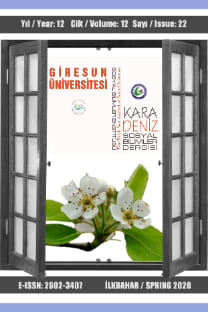“Meb Vitamin” Yazılımı Kullanımının Matematik Öğretmenlerinin Görüşlerine Göre Değerlendirilmesi “Sivas İli Örneği
A Study On The Use Of Microsoft Program Called “MEB Vitamin” In Parallel With The Views Of Mathematics Teachers “A Sample Of The Province Of Sivas”
___
- Anderson, R. (2004). “Beyond Power- Point: Building new classroom presenter”. Syllabus, June, 31—33.
- Baki, A. (2001). Bilişim Teknolojisi Işığı Altında Matematik Eğitiminin Değerlendirilmesi. [Milli Eğitim Dergisi, 149, 26-31.
- Büyüköztürk, Ş.; Kılıç—Çakmak, E.; Akgün, Ö. E. ve Karadeniz, Ş. ve Demirel, F. (2011). Bilimsel Araştırma Yöntemleri. Ankara: Pegem Yayıncılık.
- Carlson, R. D. ve Gooden, J. S. (1999). Are Teacher Preparation Programs Modeling Technology Use for Pre—Service Teachers?. ERS Spectrum, 7(3), 11—15.
- Cox, ]. R. (2006). “Screen capture on the fly: Combining molecular Visualization and tablet PC in the biochemistry lecture”. Biochemistry and Molecular Biology Education. 34{l), 12-16.
- Demirtaş, A. (2005). Eğitimde Alternatif Paradigmalar. E. Toprakçı (Ed.), Eğitim Üzerine Ankara: Ütopya Yayınevi.
- Goldstein, R. (1997). Mathematics education, computers and calculators. The next ten years. M. Selinger (Ed.), Teaching mathematics. New York: Routledge Hacısalihoğlu, H.; Mirasyedioğlu Ş. ve Akpınar A. (2004). Matematik öğretimi (1.baskı). Ankara: Asil Yayın
- Hatfield, M. M.; Edwards, N. T. ve Bitter, G. C. (1997). Mathematics methods for elemantary and middle school teachers. Boston: Allyn and Bacon.
- Kesim M. (2002). Herkes için, her yerde, her zaman etkin ögrenim: E—Öğrenme. Açık ve Uzaktan Eğitim Sempozyumu.
- Kurz, T. L. ve Middleton, J. A. (2006). Using functional approach to change preservice teachers' understanding of mathematics software. Joumal of Research on Technology in Education, 39(1), 45-65.
- Mainali, B. R. ve Key, M. B. (2012). Using dynamic geometry software GeoGebra in developing countries: case study of impressions of mathematics teachers in Nepal. The Indefinite Accumulation of Finite Amounts: Socratic Educative Experience, 2012 (1).
- MEB (2012). 6. Sınıf Öğretmen Kılavuz Kitabı.
- MEB (2012). fatihprojesi.meb.gov.tr/tr/indexphp.
- Onur M.; Topal T. ve Gürsoy A. (2009). Eğitim Bilimine Giriş. Ankara: Ümit Ofset Matbaacılık.
- Şişman, M. (2007). Eğitim Bilimine Giriş (3. Baskı). Ankara: Pegem Yayıncılık.
- Wiest, L. R. (2001). The role of computers in mathematics teaching and learning. Computers in the Schools, l7(1—2), 41-55.
- Yıldırım, A., ve Şimşek, H. (2006). Sosyal Bilimlerde Nitel Araştırma Yöntemleri Ankara: Seçkin Yayıncılık.
- TTNET (2014). http://www.vitaminegitim.com/ortaokul/
- ISSN: 2602-3407
- Yayın Aralığı: 2
- Başlangıç: 2009
- Yayıncı: -
Antikçağ Gemilerindeki Gemibaş Figürleri
İlköğret m Öğrenc ler n n Okuma Prof l n n “Okuma Eğ l mler ” Bağlamında İncelenmesi
Gıyasettn AYTAŞ, MÜZEYYEN ALTUNBAY
Güç Yönetimi ve Türk Kamu Yönetiminde Güç Yönetimi Uygulamalarının Yeri
Yasemin MAMUR IŞIKÇI, Erol IŞIKÇI
Ayten Kaya Görgün’ün “Arıza Babaların Çatlak Kızları” Adh Romanına Dair Bazı Tespitler
Ayten Kaya Görgün’ün “Arıza Babaların Çatlak Kızları” Adlı Romanına Dair Bazı Tespitler
